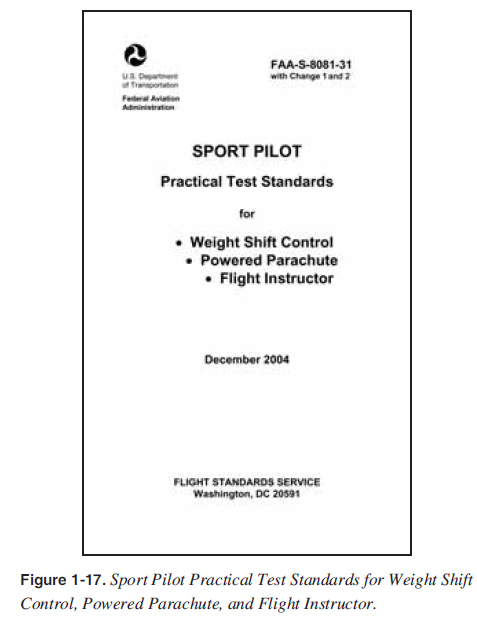
 |
|
||
CHAPTER 1. Introduction To Weight-Shift Control Basic Pilot Eligibility Title 14 CFR, part 61 specifi es the requirements to earn a pilot certifi cate. This regulation also states the pilot applicant must be able to read, speak, write, and understand the English language. The FAA Practical Test Standards (PTS) establish the standards for the knowledge and skills necessary for the issuance of a pilot certifi cate. It is important to reference both of these documents to understand the knowledge, skills, and experience required to obtain a pilot certifi cate to fl y a WSC aircraft. [Figure 1-17]  Pilot applicants and students fl ying solo must have a valid driver’s license or a current third-class medical certifi cate issued under 14 CFR part 67. In addition to a valid driver’s license or a medical certifi cate, each pilot must determine before each fl ight that he or she is medically fi t to operate the aircraft in a safe manner. If using a valid driver’s license to exercise the privileges of a sport pilot certifi cate, then all restrictions on that driver’s license are also upheld. A current FAA third-class medical certifi cate must be obtained to exercise the privileges of a WSC private pilot certifi cate. Existing pilots, including previous student pilots, who have had their FAA medical certifi cate or most recent application denied, revoked, withdrawn, or suspended by the FAA, are not allowed to operate using a driver’s license until the denial on the airman record is cleared by having a valid third class medical certifi cate issued. Flight Safety Practices In the interest of safety and good habit pattern formation, there are certain basic fl ight safety practices and procedures that must be emphasized by the fl ight instructor and adhered to by both instructor and student, beginning with the very fi rst dual instruction fl ight. These include, but are not limited to, collision avoidance procedures including proper scanning techniques and clearing procedures, runway incursion avoidance, and positive transfer of controls. Collision Avoidance All pilots must be alert to the potential for midair collision and near midair collisions. The general operating and fl ight rules in 14 CFR part 91 set forth the concept of “see and avoid.” This concept requires that vigilance shall be maintained at all times by each person operating an aircraft. Most midair collision accidents and reported near midair collision incidents occur in good visual fl ight rules (VFR) weather conditions and during the hours of daylight. Most of these accident/incidents occur within fi ve miles of an airport and/or near navigation aids. The “see and avoid” concept relies on knowledge of the limitations of the human eye, and the use of proper visual scanning techniques to help compensate for these limitations. The importance of, and the proper techniques for, visual scanning should be taught to a student pilot at the very beginning of fl ight training. The competent fl ight instructor should be familiar with the visual scanning and collision avoidance information contained in Advisory Circular (AC) 90-48, Pilot’s Role in Collision Avoidance, and the Aeronautical Information Manual (AIM). It should be noted that any turn or maneuver must be cleared before initiating. This is a most important concept in fl ying any aircraft. Look and clear the area of any aircraft or obstructions before any maneuver is performed. As an example, if a right hand turn is to be performed, the pilot must look right and clear the area before initiating any turn to the right. This “clearing procedure” must be done before performing any maneuver. This is an important habit for any student for safety purposes and is incorporated into the pilot certifi cation process. The pilot must be trained by a CFI in effectively clearing the area before any maneuver is performed. There are many different types of clearing procedures. Most are centered around the use of clearing turns. Some pilot training programs have hard-and-fast rules, such as requiring two 90° turns in opposite directions before executing any training maneuver. Other types of clearing procedures may be developed by individual fl ight instructors. Whatever the preferred method, the fl ight instructor should teach the beginning student an effective clearing procedure and require its use. The student pilot should execute the appropriate clearing procedure before all turns and before executing any training maneuver. Proper clearing procedures, combined with proper visual scanning techniques, are the most effective strategy for collision avoidance. |
| ©AvStop Online Magazine Contact Us Return To Books |